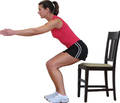 Pelvic floor health is crucial. As a mother of nine and an exercise enthusiast, I realize that probably one of the most important things that I can do is to strengthen my pelvic floor muscles. For women especially, the pelvic floor should always be thought of as key to the core muscles. While it is far too under-emphasized, it has gained attention since our mothers were giving birth. For that we should be grateful!
Pelvic floor health is crucial. As a mother of nine and an exercise enthusiast, I realize that probably one of the most important things that I can do is to strengthen my pelvic floor muscles. For women especially, the pelvic floor should always be thought of as key to the core muscles. While it is far too under-emphasized, it has gained attention since our mothers were giving birth. For that we should be grateful!
I remember being told by my ob/gyn, Dr. Tommy Megremis, after the birth of my sixth child, that I should seek out the help of a physical therapist who specialized in pelvic floor therapy because I was having symptoms of a weak pelvic floor. I actually had no idea what he was talking about! I had figured that I would simply have to bide my time before a surgical procedure would become a necessary and “normal” part of the aging process. I am grateful to Dr. Megremis for sending me in a better direction, and after working for about 4-5 months with the physical therapist, I really noticed a change. I was so encouraged.
Since that time I have twice more sought the help of a physical therapist for pelvic health (Barbara Green) and each time felt stronger for it. Often women ask me what to do about issues having to do with pelvic health and I am always amazed how few know about the physical therapy option. In fact, sports physical therapist and owner of Architech Sports , Alan Tyson, believes that just like other areas of the body that often need strengthening and rehabilitation, the pelvic floor should not be neglected, and he tells me he wishes more women would seek therapy even as soon as after their first child is born!
There are two physical therapists who are bringing attention to this topic by sharing up-to-date information and providing a wonderful source for all things having to do with pelvic health. Elizabeth H. Rummer (MSPT) and Stephanie A. Prendergast (MPT), who work at Pelvic Health Rehabilitation Center (PHRC), write at the blog Pelvic Health and Rehab. Their responses to my questions might surprise you! You will notice that I add a few comments of my own in purple after some of their responses. I know you will find the interview interesting…
Whitney: I appreciate you answering my questions, Liz and Steph. Tell me about PHRC!
PHRC is one of the very few physical therapy clinics that focuses solely on pelvic floor physical therapy. We espouse a multidisciplinary approach where we work closely with other providers to develop and implement treatment plans for our patients. The providers we commonly work with include ob/gyns, urologists, urogynocologists, colorectal specialists, pain management physicians, sex therapists, psychologists, among others. And since we’re the provider that’s going to be spending the most time with the patient, we tend to take a leadership role in the patient’s treatment, acting as CEO, if you will, of their overall healing process.
 Lastly, it’s important to us at PHRC to play a role in the education arena of the pelvic pain PT community as well as in the conversation about pelvic floor health in general. Toward that end, we teach a class titled “ Demystifying Pudendal Neuralgia as a Source of Pain: A Physical Therapist’s Approach” four times a year in different cities across the U.S.; are active in the International Pelvic Pain Society (IPPS)—Stephanie is the first PT ever to serve as the IPPS president—, the American Physical Therapy Association; and the World Congress on Pelvic Pain.
Lastly, it’s important to us at PHRC to play a role in the education arena of the pelvic pain PT community as well as in the conversation about pelvic floor health in general. Toward that end, we teach a class titled “ Demystifying Pudendal Neuralgia as a Source of Pain: A Physical Therapist’s Approach” four times a year in different cities across the U.S.; are active in the International Pelvic Pain Society (IPPS)—Stephanie is the first PT ever to serve as the IPPS president—, the American Physical Therapy Association; and the World Congress on Pelvic Pain.
Whitney: What are your backgrounds?
Stephanie received her master’s in physical therapy at the Medical College of Pennsylvania and Hahnemann University in Philadelphia. She learned about myofascial pelvic pain at the start of her career, became intrigued, and chose to dedicate her life to helping men and women suffering from these syndromes. In addition to her involvement with the IPPS and World Congress on Pelvic Pain, she recently traveled to China to help begin educating the Chinese medical community on pelvic pain treatment.
For my part, I (Liz) received my master’s in physical therapy at the University of Miami Medical School. I am a Pennsylvania native, but I soon became a San Francisco convert after moving to the city more than a decade ago. One of the things I love to do is community outreach/education here in SF. For the past year or more, I’ve held regular workshops around the city on pelvic floor-related topics, including pain and sex and postpartum health/rehab.
Whitney: What made you decide to start this blog? What are you hoping to share with men and women?
For years Steph and I have gotten emails and phone calls from people dealing with pelvic pain as well as the providers struggling to treat them. As I’m sure you’re aware, pelvic floor health and rehab is relatively under-explored territory within the medical community. While it’s come a long way in the past decade—in just the past five years even!—it remains an under-researched and misunderstood area of medicine.
Meanwhile, there are as many people suffering with pelvic pain/dysfunction as there are suffering with back pain! So while the numbers of sufferers are quite high, many struggle to find the proper diagnosis and treatment and…quite frankly, just accurate information. So we thought that a blog would help us do what we were already doing, trying to give guidance to people navigating pelvic pain, but on a more widely accessible scale. (Whitney): I am so happy to know about your resource. As one who writes about fitness and likes to share information with others, it is wonderful to find a reliable source of up-to-date wisdom regarding pelvic health!
 Whitney: Are kegels important for all women?
Whitney: Are kegels important for all women?
Historically, across the board all women were being advised to do kegels. For the most part, this is still very much the case. But here’s the thing: the only women that should be doing kegels are women who have a truly weak pelvic floor.
There are a variety of reasons that the pelvic floor can become weak; childbirth and aging are two of the most commonly discussed. However, the fact of the matter is that not everyone who has children will develop a weak pelvic floor and not everyone is going to ultimately be stuck with a weak pelvic floor due to the aging process.
So to tell all women across the board to do kegels is bad advice.
For one thing, women who have tight pelvic floors/and or trigger points within their pelvic floor muscles who do kegels could end up doing harm to their pelvic floors. In these situations kegeling could cause these women to present with pain or if they already have pain, it could worsen their pain.
For another thing, studies show that the majority of women who are told to do kegels without the proper instruction on how to do them, don’t do them correctly anyway.
And lastly, kegels will not prevent the pelvic floor from becoming weak. They can, however, when done correctly, help to strengthen an already weakened pelvic floor.

A chair squat is just one of many different types of squat exercises that are great for building strength.
Whitney: After the birth of my sixth child, I went to a physical therapist who specialized in pelvic floor muscles…and I was amazed at the difference after a few months of working with her. Biofeedback and strengthening exercises helped tremendously…is that your primary mode of rehab?
That’s wonderful that you found relief through PT! We love success stories!
To answer your question: the short answer is no. The mode of rehabilitation we deploy depends entirely on what the patient’s findings are when we evaluate him or her.
If the problem is a weak pelvic floor with poor motor control then yes, strengthening exercises are likely among the treatment methods we will deploy. But, at PHRC it’s our preference not to use a Biofeedback machine. We prefer to use manual strategies to help our patients regain motor control and strengthen their pelvic floors. That’s not to say there is anything wrong with using a Biofeedback machine, we just prefer manual, hands on treatment approaches.
Say the patient comes to us with incontinence as her (or his) primary symptom. We wouldn’t automatically assume that weakness is the issue because the fact is that there are a variety of issues beyond weakness that can cause someone to suffer with incontinence. So we would have to do a thorough evaluation to determine exactly what is causing the patient’s incontinence before we would determine what treatment approach to take. So the underlying reasons for the symptoms are what dictate our treatment approach–in every situation. There is no one-size-fits-all treatment protocol for pelvic floor problems. Each case is unique and requires a tailored treatment plan.
For instance, you’ll notice that in the first part of my response I said that strengthening exercises would most likely be what we would deploy if a patient had a weak pelvic floor. I was careful to leave wiggle room because it’s possible for a patient to present with both a weak pelvic floor and an overly tight pelvic floor with trigger points. In a circumstance such as this strengthening runs the risk of causing the patient pain. So, most likely we would have to take care of the tightness and trigger points before we could strengthen. And that’s another thing I should point out: as the patient progresses in treatment, the plan will change and evolve.
Lastly, another reason we wouldn’t depend on strengthening and biofeedback as our primary mode of rehab is that we also see patients with pain, not just weakness. And the treatment for pain is the opposite of the treatment for weakness. Pain is typically caused by a too-tight pelvic floor and/or trigger points within the pelvic floor muscles. Treatment for those impairments would involve lengthening the muscle and releasing the trigger points.
So, again, the mode of rehab depends entirely on what we find in our evaluation and consider to be the underlying reasons for the patient’s complaints.
Whitney: I have had nine children and no C-sections…is it inevitable that I will deal with problems like incontinence or prolapse?
The good news is no. There really is no hard and fast way of predicting if an individual will end up with incontinence or prolapse.
That said, there is research that shows that if a women has any level of incontinence during pregnancy than she will be more likely to suffer with it after delivery. But other than that, just because you have one child, or nine for that matter, does not mean you’ll inevitably have to deal with incontinence or prolapse.
 On the flip side, there is research that was conducted abroad in places where women are given pelvic floor rehabilitation after pregnancy and delivery that showed that as a result of the intervention, the incidence of incontinence was lowered. (France is perhaps the country most well-known for its postpartum pelvic floor rehab.) (Whitney): Alan Tyson, sports PT, has told me that he believes pelvic floor rehabilitation should begin right after birth and should be a focus of the postpartum care with women being referred to a PT who specializes in the pelvic floor. I wish I had not waited until after my sixth child was born!
On the flip side, there is research that was conducted abroad in places where women are given pelvic floor rehabilitation after pregnancy and delivery that showed that as a result of the intervention, the incidence of incontinence was lowered. (France is perhaps the country most well-known for its postpartum pelvic floor rehab.) (Whitney): Alan Tyson, sports PT, has told me that he believes pelvic floor rehabilitation should begin right after birth and should be a focus of the postpartum care with women being referred to a PT who specializes in the pelvic floor. I wish I had not waited until after my sixth child was born!
Whitney: What should we be doing to help ourselves to avoid these things?
 My best advice is that at some point in a woman’s life, whether it’s after having a child (or after each child) or when she’s reached middle age, she should see a pelvic floor PT, or in the case of prolapse a urogynocologist, and have what is, for all intents and purposes, a pelvic floor check up. The provider will be able to tell her if there is weakness and/or prolapse. If there is an issue or the beginnings of an issue, than getting evaluated at this point will be proactive in the sense that there can be some sort of intervention, which could fix the problem so that future symptoms/issues don’t arise or are not as serious if/when they do.
My best advice is that at some point in a woman’s life, whether it’s after having a child (or after each child) or when she’s reached middle age, she should see a pelvic floor PT, or in the case of prolapse a urogynocologist, and have what is, for all intents and purposes, a pelvic floor check up. The provider will be able to tell her if there is weakness and/or prolapse. If there is an issue or the beginnings of an issue, than getting evaluated at this point will be proactive in the sense that there can be some sort of intervention, which could fix the problem so that future symptoms/issues don’t arise or are not as serious if/when they do.
Here’s the thing: in our society we are accustomed to being proactive about certain health issues— colon cancer, breast cancer, our oral health—so it’s not unprecedented for a woman to be proactive in this way about preventing future problems with her pelvic floor. As women are becoming more and more aware of their pelvic floors my hope is that they will begin to go for a pelvic floor check up at some point, and in that way give themselves a chance of avoiding future issues. (Whitney): I hope so, too!
Whitney: I read an article awhile back at the blog Katysays about squats and I noticed that you also commented on that article in your blog. Since reading that article, I try to do squats fairly regularly. Do you also recommend squats for women?
It sounds as if you are talking about squatting to release your pelvic floor. If that’s the case, then yes, squats to release your pelvic floor can be helpful if you are someone dealing with an overly tight pelvic floor. This is a way to relax your pelvic floor. However, if you are someone dealing with nerve-like symptoms, such as burning, shooting, or stabbing pain in your pelvic floor region, I don’t recommend this position because it stretches the pudendal nerve, which in turn can cause irritation.
Other strategies to achieve pelvic floor relaxation are flat back pelvic floor drops and diaphragmatic breathing. However, if your goal is to strengthen your pelvic floor, none of these exercises will achieve this.
Whitney: If someone has already had a prolapse and undergone surgery, what kinds of things can she do to strengthen the pelvic floor?
There isn’t really a laundry list of exercises I can give you here because it’s not a good idea to do pelvic floor strengthening exercises in this situation without being under the supervision of a doctor or PT. That’s because before you do pelvic floor strengthening you want to know exactly what’s going on with your pelvic floor.
Whitney: If a woman is having symptoms of a prolapse, would you advise her to seek a surgical option?
It all depends on the level of the prolapse. And only a physician can determine this. However, there are levels of prolapse that can be controlled with less invasive methods, such as use of a pessary. In our book, the less invasive the option, the better as any kind of pelvic floor surgery can cause scar tissue to form, which in turn can open the door to a whole new set of issues. (Whitney): Here is a blog from your website that I thought would be great for those interested in finding a pelvic floor PT!
 Whitney: Are there certain sports or fitness routines that you tell women to avoid if they have weak pelvic floor muscles…things like tennis, running, plyometrics, jump rope exercises?
Whitney: Are there certain sports or fitness routines that you tell women to avoid if they have weak pelvic floor muscles…things like tennis, running, plyometrics, jump rope exercises?
The exercises you mention do indeed cause stress to the pelvic floor muscles and if they are truly weak can further weaken or irritate already existing symptoms. (Whitney): I have gladly given up many plyometric type exercises that involve jumping, however running will always be a cherished form of fitness for me and I hope to continue it for some time to come!
Whitney: If there is one thing women should be doing to help themselves to avoid future problems having to do with a weakened pelvic floor, what would it be?
Here my answer is the same as with the question about about avoiding incontinence and prolapse. At some point/points, if there is concern or if a woman has just had a baby, going for a pelvic floor check up is the best way to avoid problems that could arise because of weakness. Going for a pelvic floor check up can result in existing problems being caught and corrected before getting worse. Another course of action might be to see a pelvic floor PT before delivery if you are pregnant and are already dealing with any incontinence issues. (Whitney): I would have to agree. The wealth of information, strategies, and new techniques and exercises that were introduced to me by Barbara Green (PT) were tremendously helpful and I am grateful that I have found her!
Whitney: What resources can you recommend for women?
· PHRC’s Pelvic Health & Rehab Blog
· Mindandbody.org: Great website that explores the connection between pain and our brain!
· http://tallirosenbaum.com/en/blog: Talli is super-knowledgeable about pelvic health.
· http://beyondbasicspt.wordpress.com/: As is Amy at Beyond Basics.
· Happy Pelvis: http://health.groups.yahoo.com/group/happypelvis/: this is a Yahoo group that supports folks through pelvic floor PT and beyond. The members are very positive and proactive.
· http://www.ic-network.com/
· IPPS.org: stay tuned for a complete revamp of the org’s Internet presence!
Whitney: Thank you Liz and Steph for your thoughtful responses to my questions! I will continue to read your outstanding blog and consult you for your experience and knowledge in the area of pelvic health!





Speak Your Mind